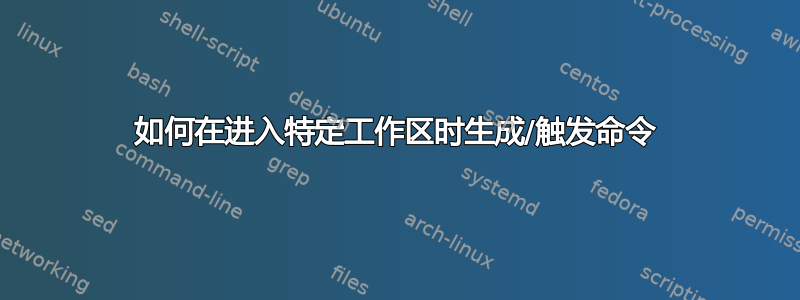
本问答与以下内容相关全屏应用期间关闭 SUPER 键。我要求让该解决方案适用于特定的工作空间。
请参阅下文以了解解决方案
答案1
介绍
此解决方案的基本工作流程是拥有一个包装器脚本,该脚本在用户进入工作区时启动用户的命令,并在用户进入不在列表中的工作区时向其发送信号。这最适合用于可以用作独立应用程序的命令,并且可以安全终止而不会丢失信息
用法
如图-h所示
usage: workspace_command_limiter.py [-h] -w WORKSPACES -c COMMAND
Runs user-defined command __upon__ entering user-defined set of workspaces.
For instance ./workspace_command_limiter.py -w 1,2,3 -c "python
/home/user/some_script.py" This is intended to serve only as launcher for a
command when user switches to their desired workspace, so consider carefully
which command you want to use. NOTE: This script does run everything from
shell, so you are here implicitly trusted not to use any command that may
break your system. I'm not responsible for your stupidity :)
optional arguments:
-h, --help show this help message and exit
-w WORKSPACES, --workspaces WORKSPACES
coma-separated list(without spaces) of workspaces
-c COMMAND, --command COMMAND
quoted command to be spawned,when switch to workspace
occurs
在脚本上下文中disable_super_key.py,这应该像这样运行
./workspace_command_limiter.py -w 1,2 -c "python ./disable_super_key.py"
请注意,在此示例中,./表示两个脚本都在同一个目录中。
脚本源
也可在github
#!/usr/bin/env python3
# -*- coding: utf-8 -*-
"""
Author: Serg Kolo , contact: [email protected]
Date: August 24th, 2016
Purpose: Runs user-requested command only on specific workspaces
Tested on: Ubuntu 16.04 LTS , Unity desktop
The MIT License (MIT)
Copyright © 2016 Sergiy Kolodyazhnyy <[email protected]>
Permission is hereby granted, free of charge, to any person obtaining a copy
of this software and associated documentation files (the "Software"), to deal
in the Software without restriction, including without limitation the rights
to use, copy, modify, merge, publish, distribute, sublicense, and/or sell
copies of the Software, and to permit persons to whom the Software is
furnished to do so, subject to the following conditions:
The above copyright notice and this permission notice shall be included in all
copies or substantial portions of the Software.
THE SOFTWARE IS PROVIDED "AS IS", WITHOUT WARRANTY OF ANY KIND, EXPRESS OR
IMPLIED, INCLUDING BUT NOT LIMITED TO THE WARRANTIES OF MERCHANTABILITY,
FITNESS FOR A PARTICULAR PURPOSE AND NONINFRINGEMENT. IN NO EVENT SHALL THE
AUTHORS OR COPYRIGHT HOLDERS BE LIABLE FOR ANY CLAIM, DAMAGES OR OTHER
LIABILITY, WHETHER IN AN ACTION OF CONTRACT, TORT OR OTHERWISE, ARISING FROM,
OUT OF OR IN CONNECTION WITH THE SOFTWARE OR THE USE OR OTHER DEALINGS IN THE
SOFTWARE
"""
# Just in case the user runs
# the script with python 2, import
# print function
from __future__ import print_function
import gi
gi.require_version('Gdk', '3.0')
from gi.repository import Gio,Gdk
from time import sleep
import subprocess
import argparse
import signal
import os
import sys
"""Set debug=True to see errors and verbose output"""
debug=False
def gsettings_get(schema,path,key):
"""Get value of gsettings schema"""
if path is None:
gsettings = Gio.Settings.new(schema)
else:
gsettings = Gio.Settings.new_with_path(schema,path)
return gsettings.get_value(key)
def run_cmd(cmdlist):
""" Reusable function for running shell commands"""
try:
stdout = subprocess.check_output(cmdlist)
except subprocess.CalledProcessError:
if debug: print(">>> subprocess:",cmdlist)
sys.exit(1)
else:
if stdout:
return stdout
def enumerate_viewports():
""" generates enumerated dictionary of viewports and their
indexes, counting left to right """
schema="org.compiz.core"
path="/org/compiz/profiles/unity/plugins/core/"
keys=['hsize','vsize']
screen = Gdk.Screen.get_default()
screen_size=[ screen.get_width(),screen.get_height()]
grid=[ int(str(gsettings_get(schema,path,key))) for key in keys]
x_vals=[ screen_size[0]*x for x in range(0,grid[0]) ]
y_vals=[screen_size[1]*x for x in range(0,grid[1]) ]
viewports=[(x,y) for y in y_vals for x in x_vals ]
return {vp:ix for ix,vp in enumerate(viewports,1)}
def get_current_viewport():
"""returns tuple representing current viewport,
in format (width,height)"""
vp_string = run_cmd(['xprop', '-root',
'-notype', '_NET_DESKTOP_VIEWPORT'])
vp_list=vp_string.decode().strip().split('=')[1].split(',')
return tuple( int(i) for i in vp_list )
def parse_args():
intro="""
Runs user-defined command __upon__ entering user-defined set of
workspaces. For instance
./workspace_command_limiter.py -w 1,2,3 -c "python /home/user/some_script.py"
This is intended to serve only as launcher for a command when user switches
to their desired workspace, so consider carefully which command you want to use.
NOTE: This script does run everything from shell, so you are here implicitly trusted
not to use any command that may break your system. I'm not responsible for your
stupidity :)
"""
parser = argparse.ArgumentParser(description=intro)
parser.add_argument(
"-w","--workspaces",
action='store',
type=str,
help="coma-separated list(without spaces) of workspaces",
required=True
)
parser.add_argument(
"-c","--command",
action='store',
type=str,
help="quoted command to be spawned,when switch to workspace occurs",
required=True
)
return parser.parse_args()
def main():
""" Defines entry point of the program """
args = parse_args()
workspaces = [ int(wp) for wp in args.workspaces.split(',') ]
if debug: print('User requested workspaces:',workspaces)
pid = None
proc = None
while True:
sleep(0.25)
viewports_dict=enumerate_viewports()
current_viewport = get_current_viewport()
current_vp_number = viewports_dict[current_viewport]
try:
if current_vp_number in workspaces:
if not pid:
proc = subprocess.Popen("exec " + args.command,shell=True)
pid = proc.pid
if debug: print('PID:',pid,'Spawned:',args.command)
else:
if pid:
if debug: print('killing pid:',pid)
proc.terminate()
proc = None
pid = None
except:
if debug: print("Unexpected error:", sys.exc_info()[0])
if proc:
proc.terminate()
if __name__ == '__main__':
main()
答案2
就像另一个选项一样,使用另一种方法来指示当前视口。我在许多脚本中使用了类似的功能,ao这里。
import subprocess
import os
import time
def get_res():
# get resolution
xr = subprocess.check_output(["xrandr"]).decode("utf-8").split()
pos = xr.index("current")
return [int(xr[pos+1]), int(xr[pos+3].replace(",", "") )]
def get_dt():
# get the current viewport
vp_data = subprocess.check_output(["wmctrl", "-d"]).decode("utf-8").split()
dt = [int(n) for n in vp_data[3].split("x")]
cols = int(dt[0]/res[0])
curr_vpdata = [int(n) for n in vp_data[5].split(",")]
curr_col = int(curr_vpdata[0]/res[0])+1; curr_row = int(curr_vpdata[1]/res[1])
return curr_col+curr_row*cols
res = get_res()
curr_dt1 = None
while True:
time.sleep(0.5)
curr_dt2 = get_dt()
# if we change viewport, do something:
if curr_dt2 != curr_dt1:
print(curr_dt2)
# if we enter viewport3, do something
if curr_dt2 == 3:
subprocess.Popen(["gedit"])
curr_dt1 = curr_dt2
该脚本检测改变在视口中以及输入具体的视口。
如果应该采取行动改变在视口中,替换打印命令:
if curr_dt2 != curr_dt1: print(curr_dt2)...通过另一个命令 (
subprocess.popen())如果行动应该在进入 ga具体的视口,替换中的命令:
if curr_dt2 == 3: subprocess.Popen(["gedit"])...由另一个进程执行。如果进程应该在以下情况下被终止:离开工作区中,添加一个部分:
if all([curr_dt1 == 3 curr_dt2 != 3]): subprocess.Popen(["<killcommand>"])


